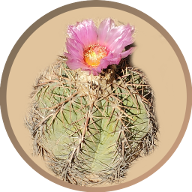Desert tortoises can live for 60-100 years old if they survive infancy, which most do not. They never stop growing but it tends to slow down once they reach the size of a large dinner plate. They are most active at dawn/dusk and on cloudy/rainy days. Never pick up or scare a desert tortoise because it could urinate, losing all of its water storage, causing the animal to die of dehydration. They can only get water from the plants they eat and from puddles during rain. They brumate from October to March, so you will never see them in the winter.
I adopted a desert tortoise named Hamm from the Arizona Game and Fish Department Tortoise Adoption Program. He lives in my backyard, which is fully enclosed and contains a wild desert garden! Hamm enjoys exploring the spacious garden with an assortment of native plants. During the heat of a summer day or the cold of winter, Hamm retreats to his burrow, which is an artificial underground cave dwelling. I describe how I built the burrow in the video below.
There are a few tips I have for building a burrow:
- Do not use cinder blocks without a solid base. If the tortoise digs under the cinder blocks they can collapse on the tortoise.
- Using wood for a tortoise burrow is tricky because it can rot and termites can eat it. You cannot treat the wood with chemicals to prevent rotting or termites because they can harm the tortoise.
- The burrow entrance needs to be above ground level to prevent flooding. However, the inside must go below ground level for temperature moderation.
- There should be enough room for the tortoise to enter and turn around at the end. However, excess room may reduce its ability to insulate.
An adopted desert tortoise makes a good pet in the desert. They live outside all year long. They need the sunshine to get vitamin D to build strong shells. If you have grasses, wildflowers, native desert shrubs, and prickly pear, they can find their own food to some degree. However, most people supplement their diet with leafy greens, grass pellets, and fruit. The tortoises love fruit but it must be given in moderation, as it can alter their gut flora and cause them to get sick. Since desert tortoises don’t pee very often, you have to be careful not to give them foods that may lead to unwanted build-ups like kidney/bladder stones. Desert tortoises should not be kept in gardens with poisonous non-native plants like the common Oleander and Lantana. Adult tortoises are relatively safe from predation, but juvenile tortoises may need additional protection from birds of prey, foxes, and coyotes. Dogs have also been known to kill desert tortoises. However, because of how ubiquitous dogs are in society, they still allow dog owners to adopt.
Unlike more traditional pets, desert tortoises do not drink water or urinate very often. Hamm only drinks from puddles during rainstorms. He refuses to drink water in dishes that I put out for him. Hamm pees about once a week, but I would assume wild tortoises go even less because their diet is not as wet. The urine is chalky white and you will need to wash it away by blasting it with a hose. The desert tortoises have a slow digestion, but if they are eating every day, they will be pooping every day! Not surprisingly, their poop tends to be like compressed grass pellets. I compost Hamms poop in a separate compost bin that I don’t use in my vegetable garden. I allow the composting process to complete over the winter while Hamm is brumating, then I have fresh compost to use in the spring.
